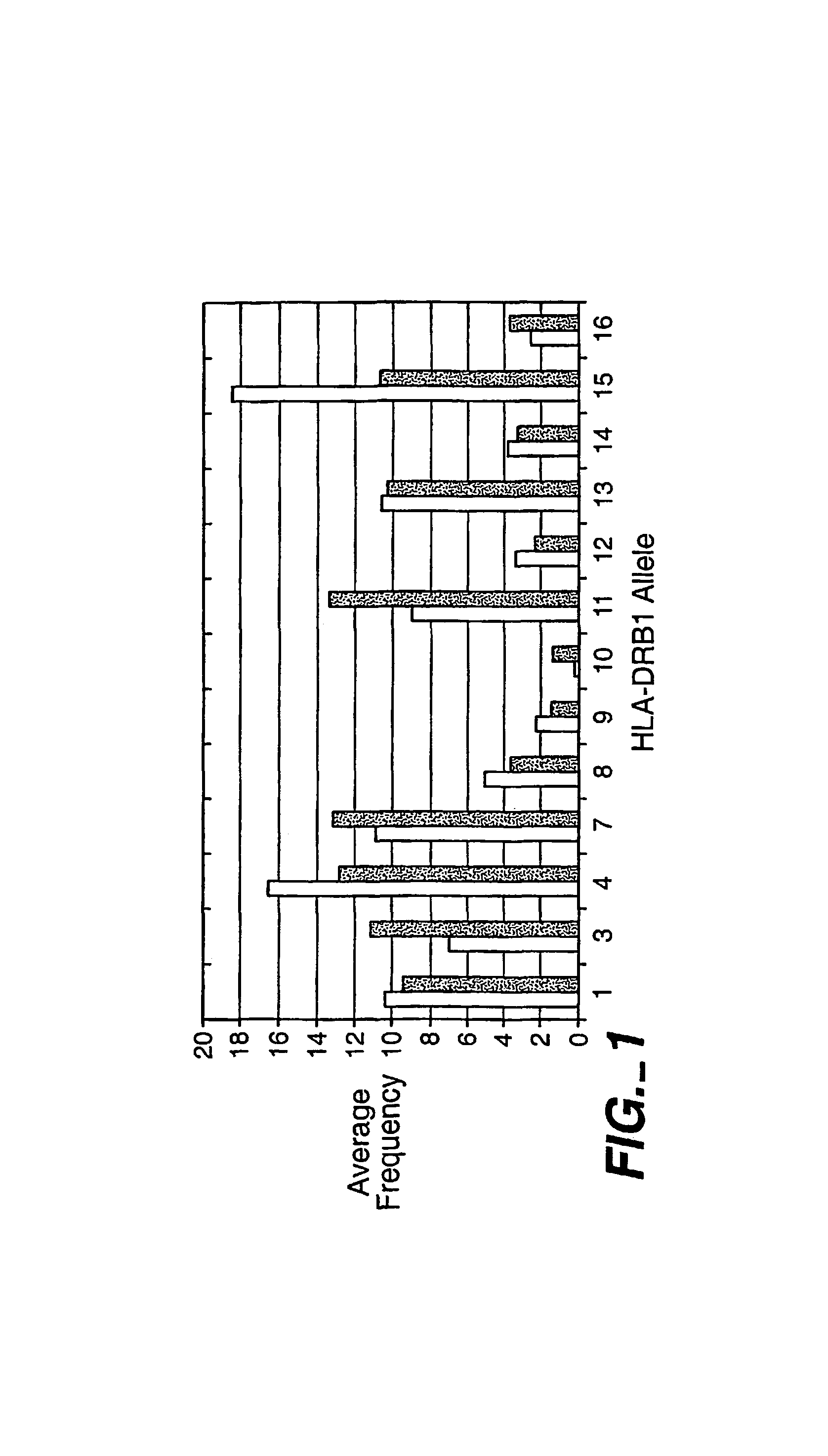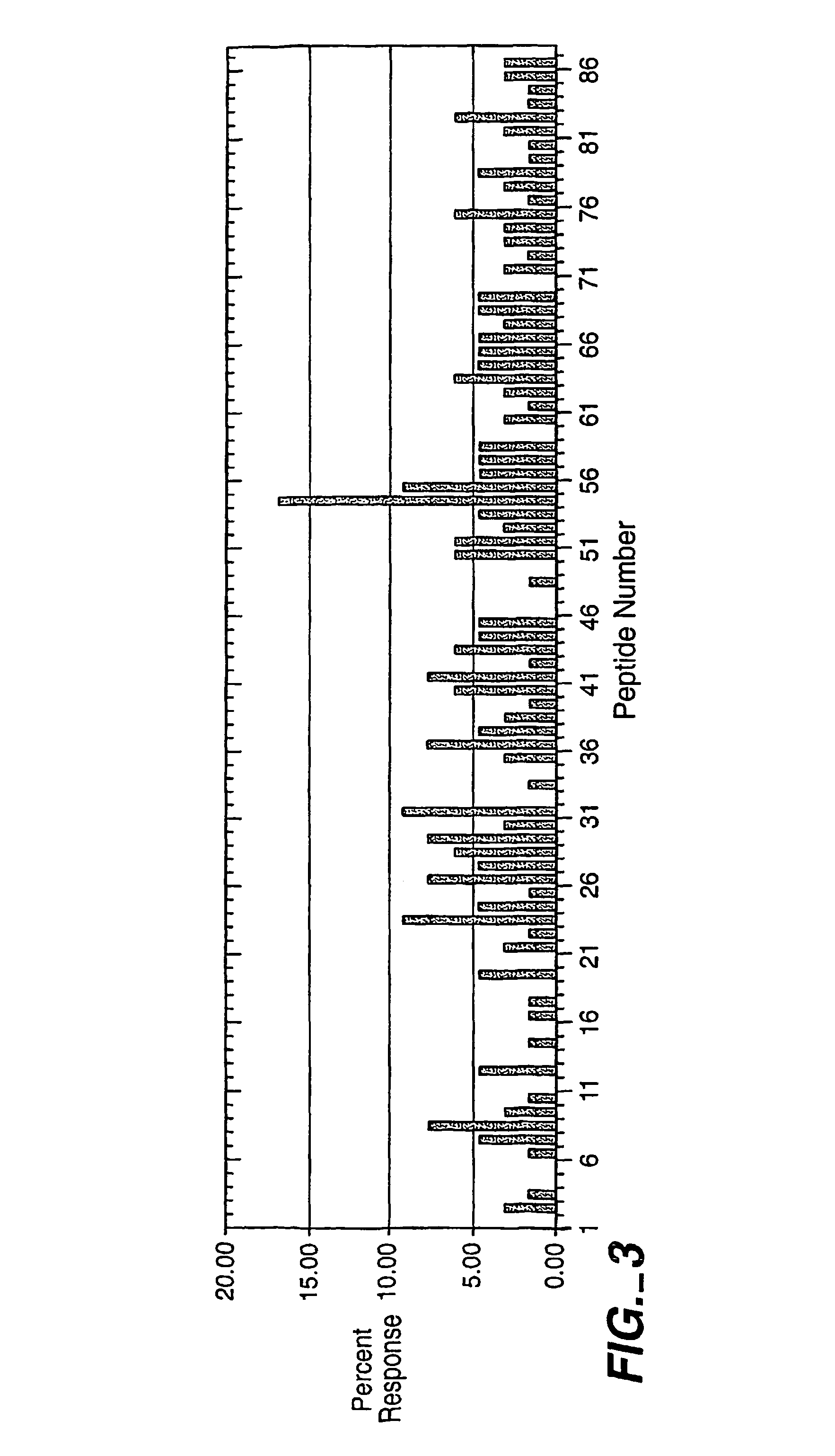Population based assessments and means to rank the relative immunogenicity of proteins
a protein and relative immunogenicity technology, applied in the field of population-based assessment, can solve the problems of no validated method to discern relative immunogenicity in humans, affecting the immunogenicity of human cells, so as to reduce the immunogenicity
- Summary
- Abstract
- Description
- Claims
- Application Information
AI Technical Summary
Benefits of technology
Problems solved by technology
Method used
Image
Examples
example 1
Compiled Results for Four Known Respiratory Allergens
[0157]In this Example, the results obtained using the I-MUNE® assay and analysis methods of the present invention described above, to test four known respiratory allergens are described.
[0158]A. Alpha Amylase
[0159]In these experiments, 82 individuals were tested with peptides derived from the alpha amylase sequence. The background response to peptides in this set was 2.80+ / −3.69%, well within the overall average obtained in tests with 11 industrial enzymes of 3.16+ / −1.57 (data not shown). Prominent responses were noted to amino acids 34-48, 160-174, and 442-456 of alpha amylase (See, FIG. 2). All three of these responses were highly significant above the background response (p<0.0001).
[0160]B. B. lentus Subtilisin
[0161]In these experiments, 65 individuals were tested with two replicate peptide sets for this protein and the results were compiled. The background for this peptide set was found to be 3.45+ / −2.90%, but within the estab...
example 2
Structure Calculations
[0166]This Example describes the structure values obtained for the four enzymes tested. Structure values are dependent on the number of donors tested. A zero response rate across most of the dataset results in a structure value of ˜1.0. The same number of responses at each peptide yields a structure value of 0. Therefore, it is important to test a peptide set until responses across the majority of the dataset are accumulated, in order for the data to accurately reflect responsivity to particular peptides and peptide regions. The structure value decreases with increasing numbers of donors tested until a plateau level is reached, usually between 2-3 responses per peptide (See, FIG. 6). The plateau structure value must be used for comparing structure values.
[0167]For each of the enzymes tested, the compiled responses were used to calculate structure within the dataset. The structure values were: 0.81 for amylase, 0.72 for ALCALASE® enzyme, 0.64 for B. lentus subti...
example 3
Comparison to Animal Models
[0171]As indicated above, two animal models have been used for the prediction of allergenicity and immunogenicity of industrial proteins. Thus, in this Example, comparisons made between these two animal models and the methods of the present invention are described. Both the guinea pig (GPIT) and BDF1 mouse (MINT) models rank the proteins in the order: amylase>ALCALASE® enzyme>B. lentus subtilisin>BPN′ Y217L. However, the relative values differ. FIG. 7 shows the structure values graphed versus the GPIT (Panel A) and MINT (Panel B) potency values. Human cell-based structure data obtained from using the methods of the present invention indicate a correlation with both methods (R2 values of 0.86 and 0.84, respectively).
PUM
| Property | Measurement | Unit |
|---|---|---|
| Tm | aaaaa | aaaaa |
| Tm | aaaaa | aaaaa |
| Tm | aaaaa | aaaaa |
Abstract
Description
Claims
Application Information
 Login to View More
Login to View More - R&D
- Intellectual Property
- Life Sciences
- Materials
- Tech Scout
- Unparalleled Data Quality
- Higher Quality Content
- 60% Fewer Hallucinations
Browse by: Latest US Patents, China's latest patents, Technical Efficacy Thesaurus, Application Domain, Technology Topic, Popular Technical Reports.
© 2025 PatSnap. All rights reserved.Legal|Privacy policy|Modern Slavery Act Transparency Statement|Sitemap|About US| Contact US: help@patsnap.com



